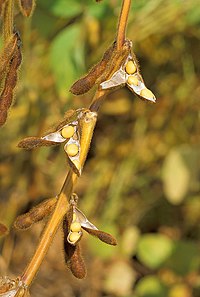
Photo from wikipedia
BACKGROUND Recently, there is a growing interest in developing protein-fortified liquid systems, which are formulated to provide special nutrient combinations to those with special dietary needs. The fabrication of heat-stable… Click to show full abstract
BACKGROUND Recently, there is a growing interest in developing protein-fortified liquid systems, which are formulated to provide special nutrient combinations to those with special dietary needs. The fabrication of heat-stable protein for protein-fortified liquid systems relies heavily on precise control of the edible protein-building process. RESULTS Results suggested that heat-stable 7S protein particles (7SPPs) could be obtained by preheating at 100 °C for an extended time, whereas 7S proteins with better gelling properties were discovered after preheating at lower temperatures. According to the findings of the protein conformational and morphological characterization, the 7SPPs showed rather stable tertiary and secondary structures as well as size distributions, which might be responsible for their heat stability. Additionally, during the reheating test, suspensions of 7SPPs showed no signs of gelation and had a low viscosity even though the protein content was as high as 120 mg mL-1 . However, 7S proteins with improved gelling properties were found to show rising aggregate size, higher susceptibility, and larger conformational structure changing rates upon reheating treatment. CONCLUSION Soy β-conglycinin (7S) proteins with tunable heat stability were successfully prepared by preheating 10 mg mL-1 protein dispersions at various temperatures (80-120 °C) and durations (15-120 min). These findings provide fundamental insights for developing 7S-based protein-fortified systems. This article is protected by copyright. All rights reserved.
Journal Title: Journal of the science of food and agriculture
Year Published: 2023
Link to full text (if available)
Share on Social Media: Sign Up to like & get
recommendations!